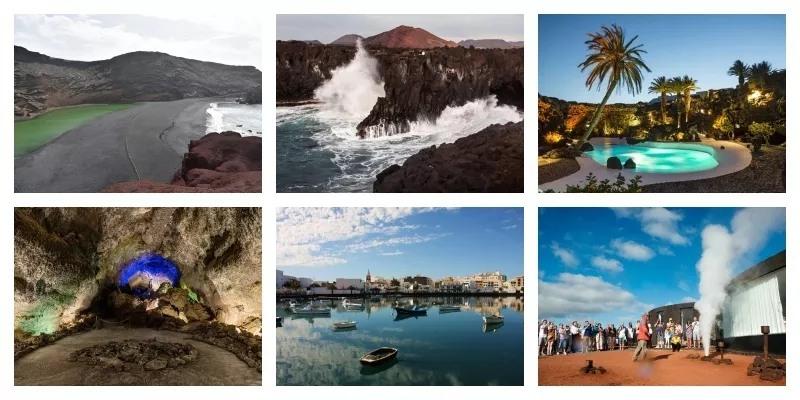THANKS TO DIGITAL LANCELOT
It will be for its volcanic landscapes in which the black of the rofe contrasts with the white sands, it will be for its blue beaches , for the impressive Geria, for its gastronomy, for its wines or, perhaps, for its Centers of Art, Culture and Tourism. Probably for all these reasons together, and many more, the Tripadvisor travel platform has chosen Lanzarote as the only Spanish destination among its Traveler’s Choice 2023 .
These are especially democratic awards since they are based on the opinions of users, those who have been uploading to the page when they have enjoyed the hotels, restaurants, leisure and all that a place has to offer. Well, Lanzarote has managed to rank 12 out of 25 and has been the only Spanish destination chosen.
If you still do not know Lanzarote, we will tell you about some corners that you cannot miss.
Famara Cove
It is a unique place on the island, and not only because of its fabulous beach, one of the most spectacular on the island, but also because of the small town of La Caleta, one of the most authentic in Lanzarote. The beach begins here, with fine, clean sand, which stretches for several kilometers to the foot of the impressive Risco of the same name. It is a windy beach with big waves, exceptional for practicing water sports, such as surfing, bodyboarding, kitesurfing or windsurfing. It is also common to see hang gliders and paragliders. Famara is also a unique setting for photographers, as well as for shooting commercials and movies. Pedro Almodóvar himself chose her to shoot fundamental scenes of “Los Abrazos rotos”. La Caleta de Famara requires a visit to all tourists and residents who are in Lanzarote.
Fire Mountains
If there is a special place, not in Lanzarote, but probably in the world, this is Timanfaya, or what is the same: the Fire Mountains. If the visitor wants to dream that he has been to the moon, he only has to visit them. They are part of the area affected by the volcanic eruptions produced in Lanzarote between 1730-1736. Inside the Timanfaya National Park there is a section of about 14 kilometers prepared for your visit. This trail, called the Route of the Volcanoes, this center was built under the direction of César Manrique and Jesús Soto in 1968. As a curiosity, also visit the El Diablo restaurant, located on the so-called Islote de Hilario, where meat and vegetables are cooked in the open oven in the volcanic stone with the heat of the volcano.
the geria
The hand of man contributed to the creation of one of the most characteristic landscapes of Lanzarote, La Geria, the main island agricultural area characterized by the peculiar way of cultivating the vineyards, product of the struggle of the island farmer to retain the water that it brings the humidity of the night. La Geria covers the center of the island and is made up of the areas of Tinajo, Yaiza, Tías, San Bartolomé and Teguise. Its declaration as a protected area has had as its objective that the traditional agricultural landscape remains unchanged. However, for the tourist it will be the image that their retinas retain when they leave, both for its beauty and for the curiosity of the technique used. This consists of clearing the land, putting arable land, covering it with ashes and building the walls to protect the vineyard from the strong wind. The humidity of the night cools the surface that retains the water as it seeps through the pores. During the day the surface is the only one that is exposed to the sun, without penetrating the rays into the ground.
Cave of the Greens
Visiting the Cueva de los Verdes is delving into the bowels of the earth, in the heart of the island, through a route, specifically one kilometer of superimposed and interconnected galleries, which allows you to enjoy an unusual environment of great beauty. His interior conditioning was carried out by Jesús Soto who displays all his knowledge about light and shadow in this tour. Ambient music, lighting and even the peculiar intervention of water contribute to turning your tour into a great experience. The chromatic range of ochres, greys, blacks and reddishes that multiply inside is impressive, blending in with the effect of light to draw grotesque landscapes and spectacular rocky structures that surprise the visitor. Entering the Cueva de los Verdes is, without a doubt,
International Museum of Contemporary Art of Lanzarote (MIAC)
Located in a singular and unique enclave, the old military fortress of Castillo de San José, the museum was established in 1975 by César Manrique. The MIAC has an internal structure that was barely modified from the original, while the most notable interventions were carried out in the annexed buildings (restaurant). The plan of the building is semicircular with the curved side facing the sea. The MIAC collections are the reflection of an artistic generation that places its production between the 50s and the 70s. It is a must-see, both for its cultural and artistic content and for the views that can be enjoyed from its restaurant.
the gulf
To the south of the island is the Gulf, an amphitheater open to the ocean that was formed as a result of the eruptions of 1730. The lagoon that occupies the bottom of the semicircle arose due to the flooding of the crater. Its green color is due to the algae that inhabit its surface. The volcano is formed by porous tuff, which, due to the action of time, has created spectacular formations. The sea passes through the crater forming a beautiful black beach that contrasts with the green of the Lake, or Charco de los Clicos, communicating with it by underground means. El Golfo, like many other places on the island, is essential for those seeking unique settings for their visual or artistic creations.
the hotbeds
They take their name from the fictional image of a boiling pot, which is nothing more than the constantly boiling ocean itself. This place, part of the Parque Natural de los Volcanes, is made up of a stretch of steep coast with the presence of caves and buffing holes created as a result of volcanic eruptions and sculpted by erosion and the force of the sea. It has delimited stone paths to make a safe visit and balconies to admire the bravery of the sea when arriving in this area. It is normal to see numerous tourists stroll through its nooks, admiring the Atlantic Ocean in all its splendor. Visiting the Hervideros is also an obligatory recommendation for all those who have not yet done so.
Jameos del Agua
They constitute, perhaps after Timanfaya, one of the most characteristic images of Lanzarote. They are located inside the volcanic tunnel produced by the eruption of the Corona Volcano and owe their name to the existence of an inland lake originated by filtration, as it is below sea level. It is the first art center created by Manrique, and the reflection of one of his creative pillars: the harmony between nature and art. Inside, he created an auditorium taking advantage of the interior of a volcanic cave. Its pool, now merely decorative, and its auditorium, attract thousands of tourists every year. Special protagonists are the blind crabs (Munidopsis Polimorpha), an endemic species to the island, continually rocked by the high and low tides, the pool of turquoise waters, and the Atlantis tunnel.
viewpoint of the river
Lanzarote’s natural viewpoint is located on top of the Risco de Famara, 400 meters above sea level, and offers one of the most spectacular panoramic views of the island and the Chinijo Archipelago. The building, created by César Manrique, has a perimeter railing made of iron and wood that gives its façade the appearance of the prow of a ship. Symbolically, the island becomes, in Manrique’s imagination, a ship sailing on the waters of the Atlantic. It is a must-see if the tourist wants to take a global image of the island with them. The construction of the Mirador del Río, which had the collaboration of the architect Eduardo Cáceres and the artist Jesús Soto, was a display of technical planning since, with the few existing means, it was necessary to proceed to excavate the land and, subsequently,
San Ginés Puddle
It is the pearl of Arrecife and not only because of its neat and picturesque appearance, but also because the heart of the island’s capital beats around the Charco de San Ginés. El Charco is a kind of lake formed by the entrance of sea water, surrounded by small fishermen’s houses and around which the old hermitage of San Ginés was built, currently converted into the Church of San Ginés. Currently, it is also the nerve center of leisure in the capital, with numerous bars, terraces, cafeterias and restaurants where you can enjoy beautiful views and a relaxing moment on a tour of the island.
The Cactus Garden
Cactus Garden. It was the last great intervention of César Manrique in Lanzarote. Built in an old rofera, Manrique knew how to turn the Cactus Garden into a very special home for cacti from all over the planet. The space is surrounded by the largest prickly pear plantation on the island dedicated to the cultivation of cochineal, a product that had great economic importance in Lanzarote in the 19th century, and houses around 4,500 specimens of 450 different species grouped into 13 families of cacti. arrived from the five continents. The green of the plants contrasts with the blue of the sky and the black of the volcano to create a harmonic explosion of color that impacts the visitor. The Cactus Garden received the Carlo Scarpa 2017 award in the hands of Antonio Martín, responsible for caring for and pampering more than 4.
the graceful
The eighth Canary Island and the eighth wonder, according to the people of Lanzarote themselves. And it is that in La Graciosa there is a unique peace and tranquility. The tourist will arrive at Caleta de Sebo, the busiest area on the island, dedicated to fishing and, currently, to the service sector. La Graciosa is ideal for exploring its paths and beaches by bicycle, since there are almost no cars, or walking, as well as for enjoying its beaches and its silence. Eating a good local fish, a paella or a fish broth in one of its restaurants is almost as obligatory as visiting the island.





